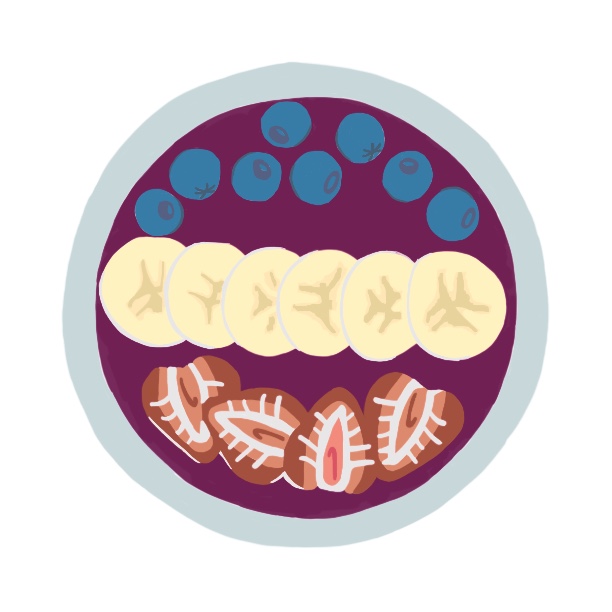Insta-worthy?
How social media has distorted society’s perception of “healthy.”
Four-year Evanston resident Laura Perry starts every Monday, Wednesday and Friday with a boost of protein from one of 4 Suns signature smoothie bowls. Whether it’s the beach smoothie, Berry bowl or plain Acai and granola, 4 Suns provides the perfect pre-workout nutrition before beginning the quick walk over to Blink. An efficient and healthy way to start the day.
What a person eats can be seen as the building block of an ideal lifestyle and can shape many other decisions in a person’s day. For many, it is the center of leading a fulfilling career while engaging in the beauty and opportunities that planet Earth has to offer. In order to achieve this mental and physical well being, restaurants have begun to prioritize foods that benefit the body. Eating locally has become a societal norm while supporting larger food corporations is looked down upon. Evanston has taken steps toward being involved in environmentally friendly food programs, reaping the benefits of nutrient-dense meals grown in their own backyard. Trendy health foods have gone in and out of fads, helping to encourage the shift toward a fruit and veggie centered diet.
Deep Purpl, home of the Brazilian Acai bowl, is a new addition to Evanston’s healthy food chain. The ambient purple lights, neon signs and abundance of thriving plants adds to the aesthetic appeal. With signature empanadas, smoothies and a variety of vegan toppings, Deep Purpl is a captivating and delicious place to enjoy a meal. Cacao nibs, Goji berries and Chia seeds are just three of the 18 toppings available to obtain iron and protein. But do protein and iron really matter when snapping pictures of your appealing, fruity choice? The line between a healthy meal and an artistic, Instagram-worthy snack becomes blurred with each vibrant topping.
“It’s like the Acai, it’s now becoming more of a show. It feels more important that it’s all purple and cool-looking while they’re straying away from the protein and nutrients – the most important part,” says sophomore Elijah Hamman.
Hamman has seen Evanston’s restaurant culture evolve.. In his eyes, healthy restaurants have shifted towards becoming more dependent on the impression that the atmosphere has on the customer, rather than the products themselves.
Certain aspects of healthy food certainly encourage the impulse to snap a pic. Vibrant colors associated with the richness and bursting flavors of fruits and vegetables are more satisfying to look at than a bag of chips. This also goes hand in hand with the simple idea that eating healthy is taking a step towards a better lifestyle which is something to be shared.
Perry speaks about the way social media works to romanticize the way eating healthy is portrayed. Although it may not be what people ultimately eat for every meal, millions of Kardashian-style salads, green smoothies and Chia seed pudding recipes are shared daily. These kinds of posts, stories and videos create the way people are perceived–constantly keeping up with the latest health trend.
“People want to be the best version of themselves, and they want to be viewed as being happy or having it figured out. Social media amplifies that. It is especially pleasant for us to digest social media information that is idealized, because it makes us attain something greater than ourselves,” Perry says.
When constantly seeing posts that augment the daily life of others, it is a habitual human desire to keep up with them. Workout routines, skincare tutorials and “what I eat in a day” videos are all trendy ways to learn the glamorized versions of someone else’s life. These posts center on theatrics of an everyday routine by working to create the perfect, elevated, yet unrealistic lifestyle. Although these trends may not always have such branded health benefits, following the pattern of others outweighs any cons.
“A lot of the times when I’m scrolling on my For You Page I see a new salad that everyone’s trying or a new vegan restaurant that just opened. People love the stuff that makes them feel better about themselves and their choices,” says Hamman.
With influencers ruling apps like TikTok and Instagram, social media becomes the ideal place to not only share, but also adapt and adopt new ideas and habits, including the growing trend of healthy food being the only component in one’s diet.
Another way healthy food is encouraged is through easy to access delivery systems. One of the most common ways is through subscription food boxes. These boxes are delivered as many days a week as desired. The meal kits provide easy to follow instructions and pre-measured ingredients to simplify as well as guide the creation of a healthy meal. Hamman sees these food boxes as a simple way to avoid the hassle of making a healthy meal.
“When my parents are at work and don’t have time to buy groceries, it allows my family to eat healthily rather than takeout or just something easy like a frozen pizza,” Hamman says.
Blue Apron, HelloFresh, Green Chef and Modify Health are all versions of the newly trending meal kits. When time is of essence, buying groceries, especially fresh produce, is a burden. Subscription food boxes like these make crafting a healthy meal much more efficient.
Time savers like these could be one reason eating healthy has been on a rise. With perfectly portioned ingredients, meal boxes limit the amount of wasted ingredients and rotten produce. They guide families, first time chefs, late night feasters, early risers and picky eaters into generating the healthy meal fit for them. All of this contributes to a more accessible and simple way to form a nutritious meal and is a factor in the ways a healthy culture has become more easily prominent.
When healthy food is accessible, reaping the benefits of a nutritious diet becomes easier for the consumer.
Perry speaks about the continual, positive circle that begins with eating healthy.
“I’ve noticed that if I’m working out, then my body wants to eat healthier and then I end up eating more nutritious foods. I feel better because I have more energy and want to do things. It ends up being this positive feedback loop.”
The foods you eat everyday not only affect energy levels but also mood and decisions. Eating in a way that makes you feel proud of yourself subconsciously encourages the way you want to take care of your body. After enjoying a homemade smoothie, it seems like the best idea to go on a run or on a trip to the gym. This is because eating healthy strengthens your immune system and gives your body more long lasting energy, reinforcing your physical and emotional well being.
This worthwhile shift in mood and energy levels is a factor in the way people make their everyday food choices. After sustaining a healthier routine and overall lifestyle, keeping up with a consistent workout and diet becomes a simpler task. Once discovering the valuable results of carrying out a healthier diet, tips and recipes become more widely spread. This raise in self esteem and feel-better attitude is yet another element in the continuous shift towards healthier food culture.
When the benefits of healthy habits are more prominent and new routines are discovered, industries and local programs like the Evanston Farmers Market help to remind consumers of the plethora of healthy food choices that they can make, one being buying locally.
Camille Walker, a worker of Evanston’s local grocery store, Village Farmstand, and director of multiple local community gardens, speaks about the shift she has seen in healthy food programs. She recalls a time before many grocery stores were walkable or in a mile radius of each other. Camile discusses the way markets have pushed towards a healthier grocery system.
“I would say the healthy food culture has grown because now we have Trader Joe’s [as of 2013], our farmers market has grown tremendously, we now have the Village Farmstand, and we’re working on getting a co-op with that. We’ve got a garden in almost every elementary school to help teach the elementary kids about it, all of which takes adult labor. There’s enough interest to keep these programs going,” Walker shares.
Markets and industries like this give Evanston residents multiple opportunities to find healthy food that is locally grown and accessible to them. The Evanston Farmers Market alone has been continuously growing ever since it began in 1976. Similarly to elementary school gardens, the Evanston Farmers Market now hosts the children’s Spud Club. This brand new addition aims to educate children about ways they can eat healthy and make their own healthy food choices.
The Village Farmstand is a two year old grocery store that provides a space for farmers and growers to sell their produce. Thanks to this program, Village Farmstand has connected customers with local farmers, thus creating more links between Evanston residents and locally grown produce. These small businesses encourage the shift from processed, packaged snacks to nutrient-rich, rainbow foods that don’t travel far.
In reiteration, a healthy routine is quickly becoming a societal norm for Evanston residents. Good health creates opportunities, improves physical and mental health, boosts self esteem, concentration, attention span and more. Although these benefits have always been present, they haven’t always been as well known. Trends have become more eminent in advertising healthy food. Food boxes and delivery systems have increased accessibility to nutritious meals. Gardens and markets have encouraged the environmentally friendly locality to a plant-based diet. Some argue that healthy food is only about the reputation it exaggerates, as being the #myplantbasedlifestyle. Others see the shift as being purely individual – each person finding their own reason why healthy food is right for them. Regardless of the reason, these factors contribute to Evanston increasing its shift towards healthier food, lifestyles and a more wholesome happiness. Or maybe hap-pea-ness.
Your donation will support the student journalists of the Evanstonian. We are planning a big trip to the Journalism Educators Association conference in Nashville in November 2025, and any support will go towards making that trip a reality. Contributions will appear as a charge from SNOSite. Donations are NOT tax-deductible.











